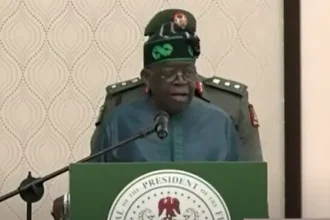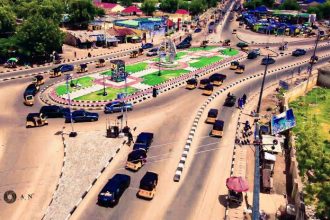Iran launched a massive ballistic missile attack against Israel late Friday and early Saturday in retaliation for Israeli strikes that killed top Iranian military leaders and nuclear scientists while damaging a key uranium enrichment facility.
The escalation marks a dangerous new phase in the long-running shadow war between the two regional rivals.
Iran’s Supreme Leader Ayatollah Ali Khamenei announced the retaliatory operation in a televised address, declaring: “We will not allow them to get away with this great crime they committed. The Armed Forces of the Islamic Republic will deal heavy blows to this enemy.”
Initial reports indicated four houses in Rishon LeZion, central Israel, were struck in the early morning barrage according to Magen David Adom emergency services. While most missiles were intercepted or fell short, at least one reportedly hit central Tel Aviv near a major military base.
Israeli Defense Minister Israel Katz condemned the attacks, stating: “Iran has crossed red lines by daring to fire missiles at civilian population centers in Israel. We will continue to defend the citizens of Israel and will ensure that the Ayatollah regime pays a very heavy price for its criminal actions.”
The exchange comes after Israeli strikes killed several senior Iranian commanders including IRGC commander Maj. Gen. Hossein Salami and Aerospace Forces head Brig. Gen. Amir Ali Hajizadeh. At least 78 people died in Friday’s Israeli raids across Iran according to Tehran’s UN ambassador, with rescue teams spending hours digging through rubble in Tehran where apartment buildings housing military officials collapsed.
Nuclear researcher Nicole Grajewski noted the unprecedented nature of the Israeli strikes: “This was in the center of Tehran, entire apartment buildings collapsed. So this was not the kind of restrained engagement we saw last year.”
The conflict risks further escalation, particularly if Iran determines the U.S. was involved. U.S. Patriot and THAAD missile systems assisted in Israel’s defense, though with less direct involvement than during previous Iranian attacks. The Biden administration had previously drawn down regional personnel in anticipation of tensions.
Among Israel’s targets were nuclear facilities at Natanz and Fordow, with the IAEA reporting radioactive contamination at Natanz. The strikes occurred despite ongoing nuclear negotiations between Iran and the U.S., with a meeting scheduled Sunday in Oman. Former President Donald Trump warned on Truth Social: “Iran must make a deal, before there is nothing left.”
In Tehran, residents described terrifying scenes as strikes continued into dawn. “It was scary at some points at night, of course. We live very close to one of the targets,” said Saba, a housewife in northern Tehran. Others reported long fuel lines as civilians prepared for further attacks.
The confrontation represents a dramatic escalation of hostilities that began expanding last year amid the Gaza war fallout. With Iran’s regional allies like Hezbollah weakened and Syria’s regime destabilized, Tehran faces this crisis more isolated than during previous confrontations with Israel.
The Middle East remains embroiled in multiple conflicts stemming from the October 7 Hamas attack on Israel and subsequent Gaza war. Recent months saw fragile ceasefires between Israel and both Hamas and Hezbollah break down, while humanitarian conditions in Gaza continue deteriorating. The U.S. maintains military support for Israel despite political tensions over the conduct of the war.







